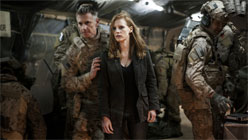That proves literally true, though not for years yet. Kathryn Bigelow and Mark Boal, director and writer of The Hurt Locker, will first send their heroine through a bureaucratic and ethical minefield — one where a colleague’s misstep proves fatal, the investigative terrain changes daily, and her superiors all have blind spots, even as to the wisdom of going after bin Laden.
That she will prevail, we know going in. But the hows and whys make Zero Dark Thirty a riveting investigative procedural for its first two hours, with a host of secondary players — particularly Jennifer Ehle as a more experienced tracker who strikes up a friendship with Maya — making brief but indelible impressions.
And the payoff coming in the final 40 minutes, after Navy SEALs plunge in stealth helicopters through a mountain range in inky blackness toward Abbottabad, is almost more startling than anything that went before.
Every action movie you’ve ever seen has prepared you for a rush through doors and up stairs when they get to the bin Laden compound. But that’s not what happened in real life. So, shooting in night-vision greens and blacks, Bigelow shows us what did happen — a careful, painstaking, methodical assault, that’s made cinematically pulse-quickening not by Hollywood flash, but by the operation’s very slowness and discipline in the face of a gathering, angry crowd.
No one who saw The Hurt Locker would expect these filmmakers to turn the hunt for the world’s most notorious terrorist into a rah-rah, get-the-bad-guy thriller. But the degree of complexity they bring to their story, starting with that opening, terrorist violence meets cruel interrogations juxtaposition, and extending to the killings in Abbottabad, has to be counted as a surprise in a major Hollywood film.
Was the death of Osama bin Laden worth the moral price, the compromised ideals? The filmmakers could hardly avoid raising those questions, but they pointedly leave them for the audience to answer. This is not a triumphant story in their telling, but it is one uncommonly freighted with the weight of history. (Recommended)
Copyright 2012 National Public Radio. To see more, visit http://www.npr.org/.


